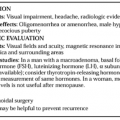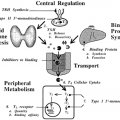CHANGES IN INDIVIDUAL PARAMETERS OF THYROID FUNCTION
TRIIODOTHYRONINE AND REVERSE TRIIODOTHYRONINE
The most prevalent and pronounced anomaly in the parameters of thyroid function during NTI is a depression in the serum total and free T3 levels. This manifestation, which is present in 70% or more of hospitalized patients, may be considered, with a few notable exceptions (discussed later), the sine qua non of the euthyroid sick syndrome.4,5 The likelihood of finding a depression of serum T3 varies with the severity of the NTI; in one study, it occurred in 23% of patients on regular hospital wards, 56% of those in intensive care units, 76% of those undergoing coronary artery bypass, and 86% of those receiving heart transplants.5 The depression in serum T3 may be pronounced, achieving levels below those seen in hypothyroid persons.6,7 Concomitant reductions in thyroid hormone–binding proteins account for less than one-third of the observed decrease in serum T3 level4; much of the remainder is attributable to a decreased peripheral monodeiodination of serum T4 (discussed later). Serum free T3, as measured by equilibrium dialysis, also is decreased in as many as 50% of patients with NTI. Given the frequency and magnitude of the T3 depression during severe
NTI, the finding of a normal or elevated T3 concentration in this setting occasionally is the first indication of a coexistent thyro-toxicosis.8 Serum reverse T3 (rT3), a metabolically inert metabolite of T4 obtained through 5-deiodination, has long been valued as a diagnostic tool in the distinction of sick euthyroid patients (elevated rT3) from patients with hypothyroidism (depressed rT3), although this is not always reliable.9,10 As with T4 and T3, serum rT3 is predominantly protein bound in the circulation. Beyond its role as the “alternate” metabolite of T4, rT3 has the ability to act as both substrate and inhibitor of type I and type II 5′-monodeiodinases, thereby potentially contributing to the decreased production of T3 seen in NTI.11
NTI, the finding of a normal or elevated T3 concentration in this setting occasionally is the first indication of a coexistent thyro-toxicosis.8 Serum reverse T3 (rT3), a metabolically inert metabolite of T4 obtained through 5-deiodination, has long been valued as a diagnostic tool in the distinction of sick euthyroid patients (elevated rT3) from patients with hypothyroidism (depressed rT3), although this is not always reliable.9,10 As with T4 and T3, serum rT3 is predominantly protein bound in the circulation. Beyond its role as the “alternate” metabolite of T4, rT3 has the ability to act as both substrate and inhibitor of type I and type II 5′-monodeiodinases, thereby potentially contributing to the decreased production of T3 seen in NTI.11
TOTAL THYROXINE
Thyroxine levels enjoy a greater degree of stability than do T3 levels during NTI of mild or moderate severity. However, with increasing gravity of the underlying illness, the serum total T4 levels may be subnormal in as many as 20% to 50% of hospitalized patients.5,6 and 7,12,13 Extremely low serum T4 levels portend a fatal outcome to an extent that rivals traditional prognostic indices (see later). Conversely, a rise in T4 levels accompanies the recovery phase of illness in patients who survive critical illness (see Fig. 36-1). Hyperthyroxinemia may be seen occasionally in NTI, although this generally occurs in a predictable fashion in association with certain hepatic disorders or acute psychiatric illnesses, or in conjunction with specific medications (see later).
Stay updated, free articles. Join our Telegram channel

Full access? Get Clinical Tree





